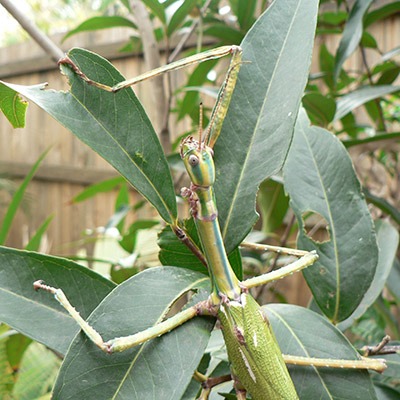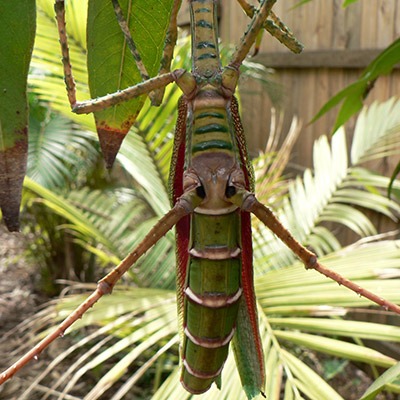See our other stick insect factsheets
Children’s Stick Insect
Goliath Stick Insect
Spiny Leaf Insect
Titan Stick Insect
Stick & Leaf Insects (Phasmatodea)

Description:
Stick and leaf insects have long stick-like bodies that grow between 3 – 30cm in length. Their bodies resemble leaves, sticks or grass, which makes them extremely good at camouflage. They usually have two pairs of wings, although some species are wingless.
Life Cycle:
Female stick insects are generally larger than the males. The males can usually fly really well and will zoom around looking for females. Female stick insects lay hundreds of eggs, which are usually dropped from their abdomen down onto the ground where they lay amongst the leaf litter waiting to hatch. Some species will glue their eggs to sticks and leaves or bury them in the soil. The young stick insects are called nymphs and look just like the adults only much smaller and with no wings. Nymphs have to shed their skin (just like a snake) every few weeks so that they can grow larger.
Favourite foods:
Stick insects are herbivores, which means they only eat plants. They are the vegetarians of the insect world and love to chow down on leaves, grasses and sometimes even flowers and bark. Some stick insects are very picky and will only eat one or two certain kinds of plants. Many stick insects are nocturnal which means they do most of their feeding at nighttime to avoid predators like birds, which are more active during the day.

© Mount Glorious Biological Centre

Defence tactics:
Stick insects make a tasty snack for many animals such as birds, possums, lizards, frogs, spiders and ants. Because they have so many enemies, stick and leaf insects have developed some pretty cool ways to defend themselves. In addition to their incredible camouflage, stick insects will often drop to the ground and play dead to avoid getting eaten. Some will kick with their spiky legs, flash brightly coloured wings and make hissing sounds to scare away an enemy. Stick insects can also drop off one or more of their legs to escape a predator (much like a lizard losing their tail).
Some stick insects even shoot nasty chemicals into the eyes of their enemies to blind them! The Peppermint Phasma from North Queensland shoots a jet of white liquid from the back of its thorax into the face of an attacker. It can squirt this liquid over 20cm! Not only does it burn the eyes and cause temporary blindness, the liquid smells exactly like peppermint toothpaste (which is how the Peppermint Phasma get its name)!
Fascinating Facts:
- The longest known stick insect in the world is called Phobaeticus serratipes, which is found around Malaysia. It measures 55.5cm from the tips of its legs to the end of its abdomen. That’s over half a meter!
- There are over 2500 different species of stick insects in the world, with around 150 in Australia.
- People in China and parts of Malaysia believe that stick insects are good luck and will often keep them as pets in their homes.
- The technical name for stick insect poo is frass.
- The Chinese make a tea out of stick insect frass and drink it! They believe it cures everything from stomach aches to asthma. Eeewwww!
Click on the names below to learn more about some common Australian stick insects.
Goliath
Titan
Children’s
Spiny Leaf
